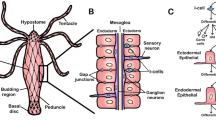Summary
In isolated eyestalks of the crab,Leptograpsus variegatus, retinula cells exposed to a small volume of bathing medium will synthesize and assemble new rhabdomeres in the same circumstances as the intact animal; that is, in response to normal laboratory dusk, to early dusk, and in the absence of darkness if light is continued past the normal dusk time. Under some conditions cytoskeletal elements are preserved which are not normally seen in this tissue with the usual fixation and dissection techniques. More reduced preparations consisting of cornea and retina, with or without the lamina, are sufficiently viable to allow experiments on at least the initiation of synthesis. Synthesis in response to early darkness is not dependent on input from outside the retina. Indications of synthesis are also found in reduced preparations held in the light over normal dusk time, implying that the endogenously triggered synthesis is also independent of extraretinal factors.
Similar content being viewed by others
Abbreviations
- ER :
-
endoplasmic reticulum
References
Barlow RB Jr, Bolanowski SJ Jr, Brachman ML (1977) Efferent optic nerve fibers mediate circadian rhythms in theLimulus eye. Science 197:86–89
Behrens M (1974) Photomechanical changes in the ommatidia of theLimulus lateral eye during light and dark adaptation. J Comp Physiol 89:45–57
Blest AD (1978) The rapid synthesis and destruction of photoreceptor membrane by a dinopid spider: a daily cycle. Proc R Soc Lond [Biol] 200:463–483
Blest AD (1980) Photoreceptor membrane turnover in arthropods: comparative studies of breakdown processes and their implications. In: Williams TP, Butler BN (eds) The effects of constant light on visual processes. Plenum Press, New York, pp 217–246
Blest AD, Stowe S, Eddey W (1982a) A labile Ca2+-dependent cytoskeleton in the rhabdomeral microvilli of blowflies. Cell Tissue Res 223:553–573
Blest AD, Stowe S, Eddey W, Williams DS (1982b) The local deletion of a microvillar cytoskeleton from photoreceptors of tipulid flies during membrane turnover. Proc R Soc Lond [Biol] (in press)
Burton PR, Stockhammer KA (1969) Electron microscopic studies of the compound eye of the toadbugGelastocoris oculatus. J Morphol 127:233–258
Fleissner G, Fleissner G (1978) The optic nerve mediates the circadian pigment migration in the median eyes of the scorpion. Comp Biochem Physiol [A] 61:69–71
Frixione E, Aréchiga H, Tsutsumi V (1979) Photomechanical migrations of pigment granules along the retinula cells of the crayfish. J Neurobiol 10:573–590
Hafner GS, Hammond-Soltis G, Tokarski T (1980) Diurnal changes of lysosome-related bodies in the crayfish photoreceptor cells. Cell Tissue Res 206:319–332
Hafner GS, Tokarski T, Hammond-Soltis G (in press) Development of the crayfish retina: a light and electron microscopic study. J Morphol
Hays EA, Lang MA, Gainer H (1968) A re-examination of the Donnan distribution as a mechanism for membrane potentials and potassium and chloride ion distributions in crab muscle fibres. Comp Biochem Physiol 26:761–792
Kirschfeld K, Vogt K (1980) Calcium ions and pigment migration in fly photoreceptors. Naturwissenschaften 67:516
Larimer JL, Smith JTF (1980) Circadian rhythm of retinal sensitivity in crayfish: modulation by the cerebral and optic ganglia. J Comp Physiol 136:313–326
Ludolph C, Pagnanelli D, Mote MI (1973) Neural control of migration of proximal screening pigment by retinula cells of the swimming crabCallinectes sapidus. Biol Bull 145:159–170
Nässel DR, Waterman TH (1979) Massive diurnally modulated photoreceptor membrane turnover in crab light-dark adaptation. J Comp Physiol 131:205–216
Odselius R, Elofsson R (1981) The basement membrane of the insect and crustacean compound eye: definition, fine structure and comparative morphology. Cell Tissue Res 216:205–214
Olivo RF, Larsen EM (1978) Brief exposure to light initiates screening pigment migration in retinula cells of the crayfish,Procambarus. J Comp Physiol 125:91–96
Payne R (1980) Voltage noise accompanying chemically-reduced depolarisation of an insect photoreceptor. Biophys Struct Mech 6:235–254
Payne R (1981) Chemical modifications to transduction in an insect eye. PhD thesis, Australian National University
Shaw SR (1978) The extracellular space and blood-eye barrier in an insect retina: An ultrastructural study. Cell Tissue Res 188:35–61
Stowe S (1980a) Rapid synthesis of photoreceptor membrane and assembly of new microvilli in a crab at dusk. Cell Tissue Res 211:419–440
Stowe S (1980b) Spectral sensitivity and retinal pigment movement in the crabLeptograpsus variegatus (Fabricius). J Exp Biol 87:73–98
Stowe S (1981) Effects of illumination changes on rhabdom synthesis in a crab. J Comp Physiol 142:19–25
Stowe S, Ribi WA, Sandeman DC (1977) The organisation of the lamina ganglionaris of the crabScylla serrata andLeptograpsus variegatus. Cell Tissue Res 178:517–532
Strausfeld NJ, Nässei DR (1981) Neuroarchitectures serving compound eyes of Crustacea and insects. In: Autrum H (ed) Handbook of sensory physiology, vol VII/6B. Springer, Berlin Heidelberg New York, pp 1–132
Waterman TH (1982) Fine structure and turnover of photoreceptor membranes. In: Westfall JA (ed) Visual cells in evolution. Raven Press, New York, pp 23–42
Williams DS (1982a) Ommatidial structure in relation to photoreceptor membrane turnover in the locust. Cell Tissue Res (in press)
Williams DS (1982b) Photoreceptor shedding and assembly can be initiated locally within an insect retina. Science (in press)
Yamashita S, Tateda H (1981) Efferent control in the eyes of orb weaving spiders. J Comp Physiol 143:477–483
Author information
Authors and Affiliations
Rights and permissions
About this article
Cite this article
Stowe, S. Rhabdom synthesis in isolated eyestalks and retinae of the crabLeptograpsus variegatus . J. Comp. Physiol. 148, 313–321 (1982). https://doi.org/10.1007/BF00679016
Accepted:
Issue Date:
DOI: https://doi.org/10.1007/BF00679016




